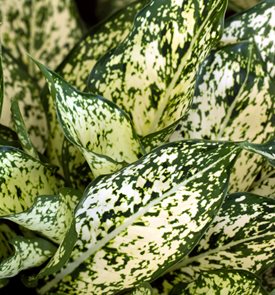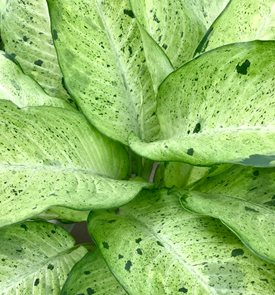Grow Dieffenbachia for Fabulous Foliage
Learn how to transform your indoor decor with this showy, easy-to-grow houseplant.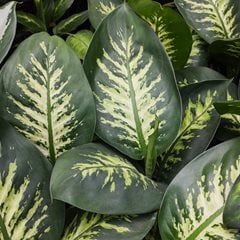
Photo by: Silviopl / Shutterstock
Every home has one—a dark corner or an empty shelf that’s crying out for some decorative greenery. Dieffenbachia (dumb cane) plants are the perfect solution for creating an immediate impact in those barren spaces. Flaunting large, lush green leaves painted with brush strokes of creamy yellow, white, or gold, these exotic-looking aroids beg to be noticed.
Dieffenbachia plants are great for improving indoor air quality because the large leaves are highly efficient at filtering out pollutants. However, be aware that this beautiful houseplant can be toxic for people and pets alike. With proper precautions, you'll be able to enjoy all the ornamental attributes this plant has to offer.
On this page: Basics | Growing | Care | Varieties | Troubleshooting
On this page:
DIEFFENBACHIA BASICS
Botanical name:
Dieffenbachia spp.
Common names:
Dieffenbachia, dumb cane, leopard lily
Origin:
Tropical regions of the Caribbean and South Africa
Growth rate:
Fast growing; up to 2 feet in a year under ideal growing conditions
Size:
3 to 6 feet tall, 1 to 3 feet wide
Foliage:
Pointed, oblong, and glossy, usually sporting variegated patterns of white, yellow, gold, and different shades of green. Can grow to 12 inches or longer.
Flowers:
May occasionally produce pale green flowers (similar to those of its aroid cousin, the peace lily), when grown under optimal conditions.
Are dieffenbachia plants toxic?
All parts of the plant contain calcium oxalate crystals that are toxic to dogs and cats. The sap can also irritate the skin and eyes. Keep dieffenbachia plants out of reach of children and pets (see this guidance from the ASPCA). Also, wear gloves when handling the plant.
GROWING DIEFFENBACHIA
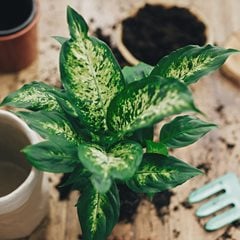
Photo by: Bogdan Sonjachnyi / Shutterstock
Light:
Dieffenbachia tolerates a wide range of light conditions, but grows best in bright, indirect light, such as from an east- or west-facing window. Most plants will also do fine in darker areas of the home, but they won’t grow as vigorously and may become spindly. Avoid direct sunlight, which can scorch the leaves and cause the colors to fade.
TIP: To ensure even growth, rotate your dieffenbachia regularly so it receives light from all sides. Otherwise, it tends to lean towards the light source.
Temperature:
Prefers average room temperatures of 65° to 75° F. Keep away from cold drafts and temperatures below 55° F.
Humidity:
Like most tropical houseplants, dieffenbachias prefer moderate to high humidity. In drier areas of the home, you can keep your plants hydrated by misting the leaves, setting them on a tray filled with pebbles and water, or grouping your dieffenbachia with other houseplants.
Soil:
Use a well-draining potting mix that has good moisture retention.
DIEFFENBACHIA PLANT CARE
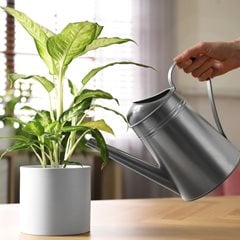
Photo by: New Africa / Shutterstock
Watering:
Water regularly spring through fall, allowing the soil to dry to a depth of 1 inch between watering. Water less often during the winter. To avoid soggy soil, which can lead to root rot, make sure there are sufficient drainage holes in the bottom of the pot so your plant will drain completely after watering.
Fertilizing:
In March through September, fertilize every two weeks using a liquid houseplant fertilizer diluted by half. Feed less often if your plant is growing in low light. Stop fertilizing in winter.
Pruning and shaping:
As dumb canes mature, lower leaves naturally drop off to reveal thick stems, resulting in a palm-tree-like appearance. If you want a bushier plant, simply cut the canes back to the desired height and new growth will emerge below the cut. It’s best to cut the canes at a 45-degree angle just above a leaf node, making sure not to remove more than a third of the plant’s foliage.
CAUTION: Always wear gloves when pruning a dumb cane to avoid skin contact with the plant sap. Also avoid touching your face and eyes.
Leaf care:
Keep the foliage nice and shiny by cleaning it occasionally with a damp cloth. This is also a good opportunity to check for pests that may be hiding under the large leaves.
Repotting:
Due to its fast growth rate, it may be necessary to repot your Dieffenbachia every year or two. Move it to a pot that is about 2 inches wider and slightly deeper than the existing container. Plant larger varieties, such as 'Tropic Snow' in a heavy container to keep them from tipping over.
Propagation:
It's easy to propagate a Dieffenbachia from cane cuttings or stem tip cuttings taken during pruning. Cut the bare canes into 2-inch pieces, ensuring each piece includes a node. Lay them horizontally on moist potting soil or another rooting medium until roots develop. Stem tip cuttings with leaves attached can be propagated by placing them right side up in soil or water.
Pests:
Inspect the foliage weekly for common houseplant pests such as mealybugs, whiteflies, scale and spider mites. Once you spot an offender, treat the plant immediately to avoid an infestation. (See more on how to get rid of pests on houseplants)
DIEFFENBACHIA VARIETIES
COMMON PROBLEMS WITH DIEFFENBACHIA
Dieffenbachias are usually trouble-free, but when they are unhappy with their growing conditions, the foliage is often the first thing to suffer. Here are some common warning signs to look for:
- Leaves falling off: It’s normal for a dieffenbachia plant to lose some of its lower leaves, but if the leaves begin to drop off randomly, sudden temperature fluctuations or exposure to cold drafts could be the cause. Also check for signs of pests and diseases.
- Yellowing leaves: Usually an indicator of overwatering, especially if the stems are becoming soft and discolored. Prune off the damage and wait until your plant dries out before watering again. The leaves may also yellow if your plant is lacking nutrients or needing more sunlight.
- Leaf discoloration or fading: Often due to direct exposure to bright light. Move your plant back from the window or to a new location away from streaming sunlight.
- Brown leaf tips or edges: May be due to low humidity, too much fertilizer, or inconsistent watering. If the air is dry, mist the leaves occasionally or place the pot on a tray filled with wet pebbles.
RELATED:
21 Best Indoor Plants
Best Low-Light Houseplants
A Guide to Growing Peace Lily
A Guide to Growing Pothos



